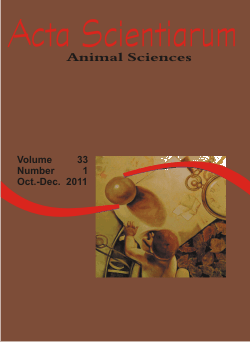<b>Rice husks and soy straw as substrate for composting of broiler carcasses</b> - doi: 10.4025/actascianimsci.v33i1.10824
Keywords:
physiochemical composition, decomposition, composting piles
Abstract
The performance of rice husks and of soy straw were evaluated as substrate for on-farm poultry carcass composting, observing the degradation of the two substrate and of the carcasses through monitoring the temperature, weight of the carcasses and of the substrate and physiochemical analysis of the final product. The piles were arranged with carcasses of 10 recently slaughtered birds, with four repetitions in time. A thermo pair was installed in each pile to register the temperature. The substrate and the carcasses were weighed separately, in the beginning, day 15 and day 30 of composting. At the end of each period, the physiochemical analysis of samples were made from each pile, evaluating the pH, the dry material, ashes, P, N, K, Cu, Zn, Mn, Fe and organic carbon. The conclusion was that soy straw can be used as alternative for substrate for composting of broiler carcasses, complying to the C/N demanded by the legislation at the end of the third reuse. The rice coat can also be used as substrate for composting of broiler carcasses and reused a larger number of times. The decomposition of the carcasses was significantly larger, in percentage, in the soy straw at the end of the fourth composting period (p < 0,05).Downloads
Download data is not yet available.
Published
2011-02-02
How to Cite
Abreu, P. G. de, Paiva, D. P. de, Abreu, V. M. N., Coldebella, A., & Cestonaro, T. (2011). <b>Rice husks and soy straw as substrate for composting of broiler carcasses</b> - doi: 10.4025/actascianimsci.v33i1.10824. Acta Scientiarum. Animal Sciences, 33(1), 51-57. https://doi.org/10.4025/actascianimsci.v33i1.10824
Issue
Section
Animal Production
DECLARATION OF ORIGINALITY AND COPYRIGHTS
- I Declare that current article is original and has not been submitted for publication, in part or in whole, to any other national or international journal.
The copyrights belong exclusively to the authors. Published content is licensed under Creative Commons Attribution 4.0 (CC BY 4.0) guidelines, which allows sharing (copy and distribution of the material in any medium or format) and adaptation (remix, transform, and build upon the material) for any purpose, even commercially, under the terms of attribution.
Read this link for further information on how to use CC BY 4.0 properly.
0.9
2019CiteScore
29th percentile
Powered by 








































